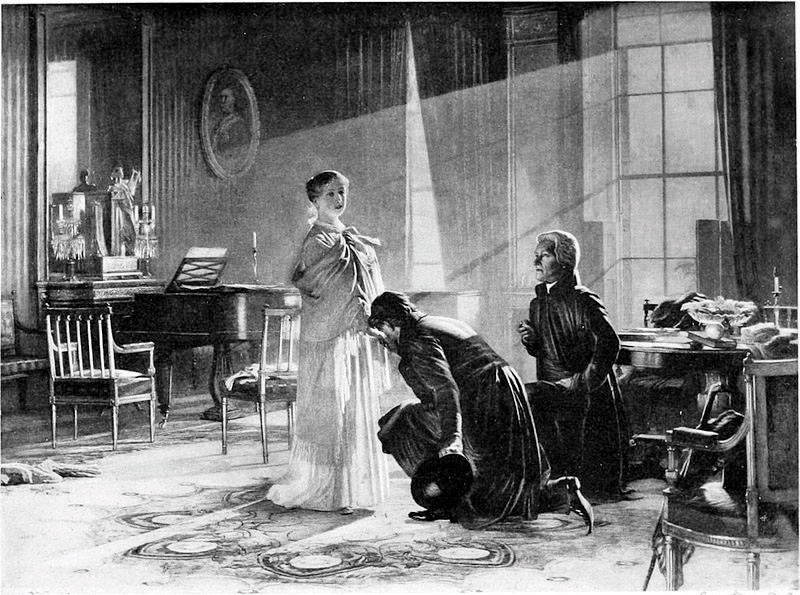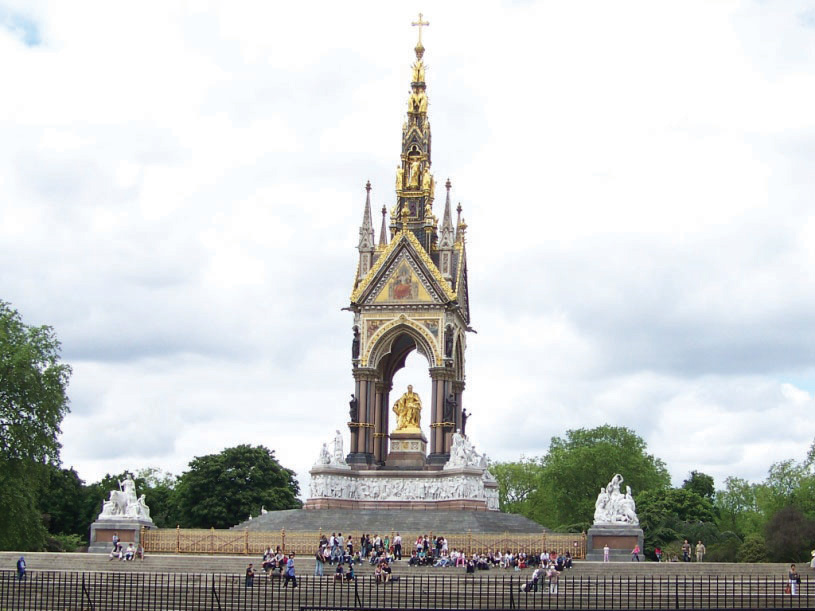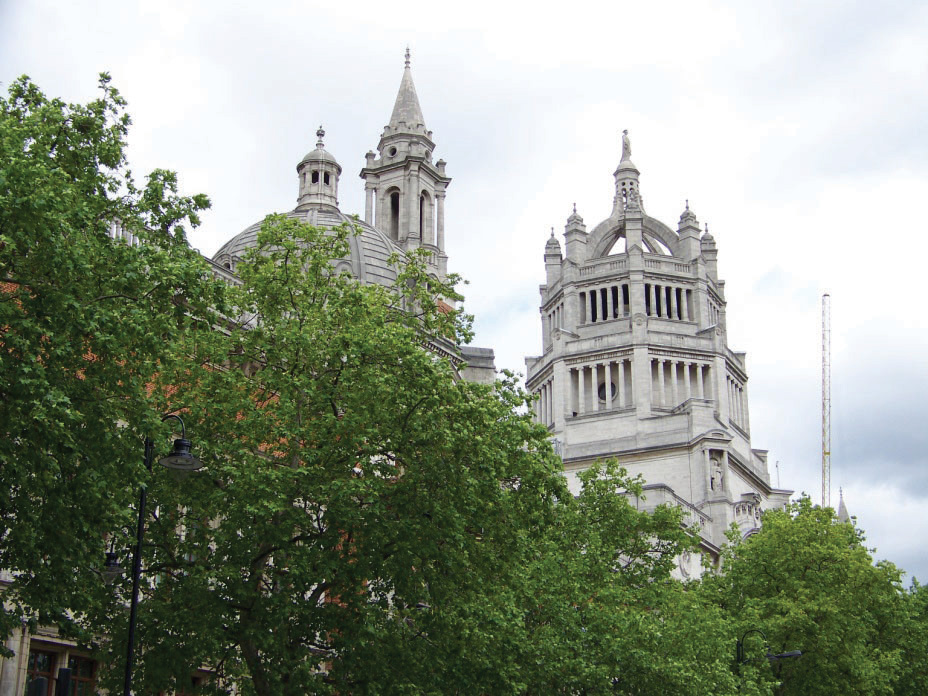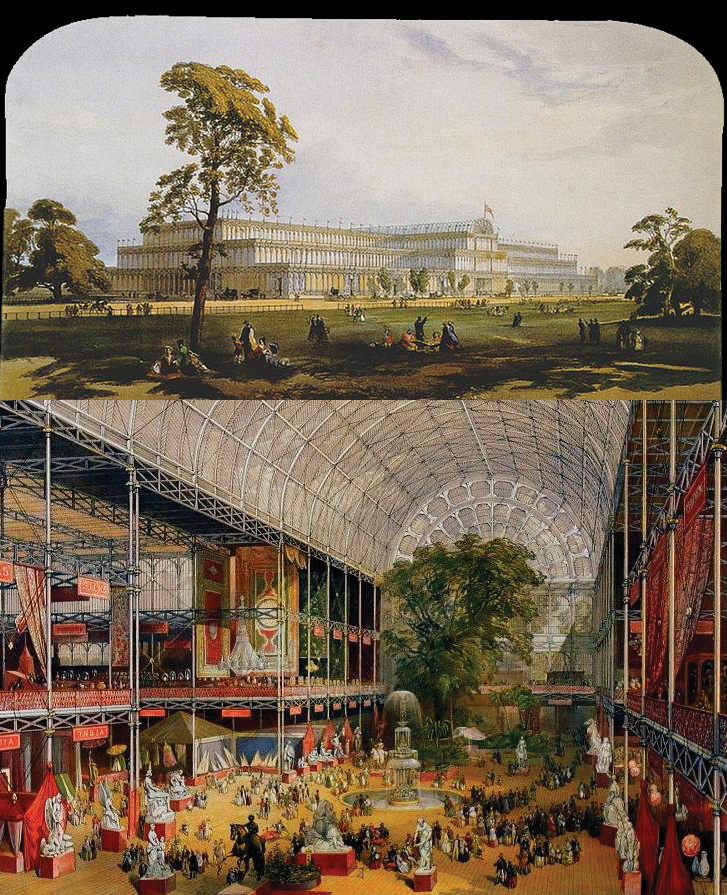7.1: The Victorian Era (1832–1901)
- Page ID
- 134615
- Recognize and evaluate the influence that Queen Victoria and Prince Albert exerted on the last half of the 19th century.
- Identify and explain the conflicts that defined the Victorian Era.
- Assess the ways in which these conflicts influenced Victorian literature.
- List, define, and give examples of typical forms of Victorian literature.
“It was the best of times, it was the worst of times…”
Charles Dickens, A Tale of Two Cities
The Victorian Age—the era when the sun never set on the British Empire, a time when the upper classes of Britain felt their society was the epitome of prosperity, progress, and virtue—Dickens’s words, however, could apply to his own Victorian age as well as they apply to the French Revolution setting of his novel. The Victorian Era was a time of contrasts—poverty as well as prosperity, degrading manual labor as well as technological progress, and depravity as well as virtue.
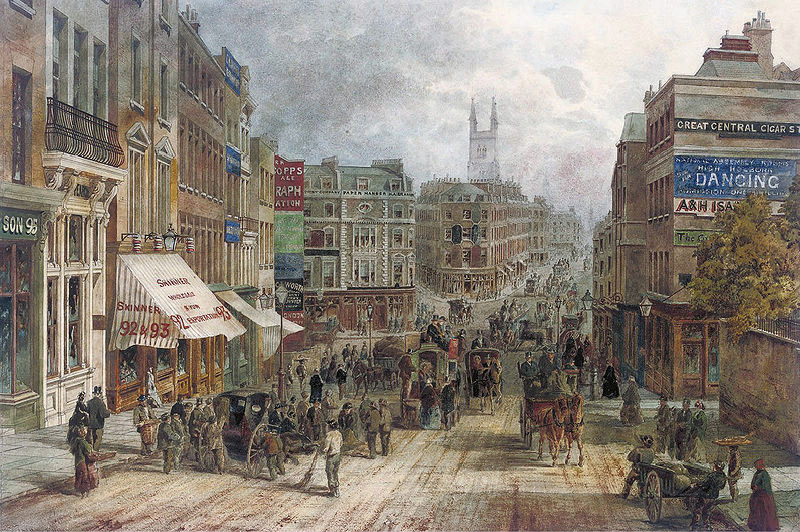
Snow Hill, Holburn, London (Anonymous).
Queen Victoria
The last seventy years of the 19th century were named for the long-reigning Queen Victoria. The beginning of the Victorian Era may be rounded off to 1830 although many scholars mark the beginning from the passage of the first Reform Bill in 1832 or Victoria’s accession to the throne in 1837.
Victoria was only eighteen when her uncle William IV died and, having no surviving legitimate children, left the crown to his niece.
Victoria receives the news that she is Queen. Engraved by Emery Walker (1851–1933), from the picture by Henry Tanworth Wells (1828–1903) at Buckingham Palace.
Although by the 19th century Britain was a constitutional monarchy and the queen held little governing power, Victoria set the moral and political tone of her century. She became a symbol of decency, decorum, and duty.
Three years into her reign, Victoria married Albert of Saxe-Coburg-Gotha, a region in what is now Germany. Prince Albert (given the title “Prince” by Victoria), although he had no actual power in the government, became one of Victoria’s chief advisors and a proponent of technological development in Britain. Together the couple had nine children who married into many of Europe’s royal and noble families. Victoria and Albert were considered the model of morality and respectable family life.
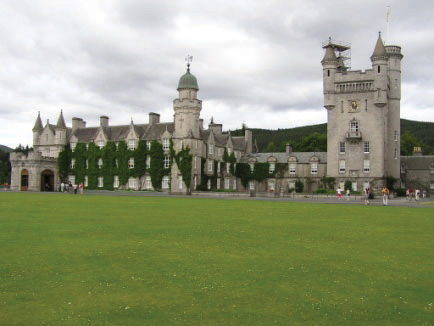
Balmoral Castle, the royal residence in Scotland.
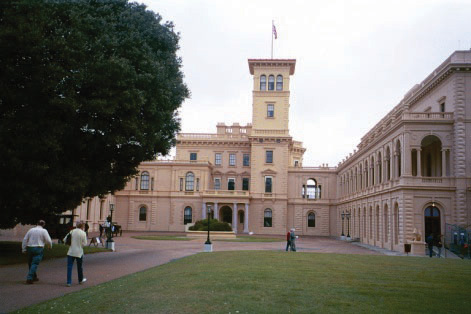
Osborne House, the royal residence on the Isle of Wight.
When Prince Albert died in 1861, Victoria retired from public view, spending time in her Balmoral Castle in Scotland or Osborne House on the Isle of Wight. Public opinion of the queen waned as years passed without her resuming her official duties. Even when she conceded to her advisors’ urging to return to London and to honor her public obligations, she continued to wear mourning until her own death. She also commissioned many public memorials to Prince Albert, including the Albert Memorial in Hyde Park (near the original location of the Crystal Palace), Royal Albert Hall, and the Victoria & Albert Museum.
The Albert Memorial, Hyde Park, London.
Royal Albert Hall, London.
The ornamental dome on the Victoria & Albert Museum was modeled after Queen Victoria’s favorite crown, visible in the portrait below, now on display with the Crown Jewels at the Tower of London.
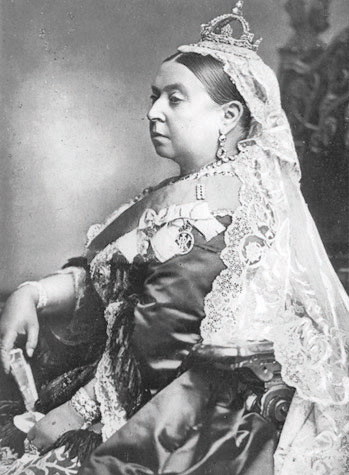
Photograph by Alexander Bassano 1829–1913.
Queen Victoria reigned as Queen of the United Kingdom and Empress of India until her death in 1901.
Victorian Conflicts
The Victorian Era was, in many ways, paradoxically “the best times” and “the worst of times.”
Conflicts of Morality
Queen Victoria embodied ideals of virtue, modesty, and honor. In fact, the term Victorian has in the past been almost a synonym for prim, prudish behavior. At the same time, London and other British cities had countless gaming halls which provided venues not just for gambling but also opium dens and prostitution. With the influx of population into the cities, desperate working class women turned to prostitution in attempts to support themselves and their children. Historian Judity Walkowitz reports that 19th century cities had 1 prostitute for every 12 adult males (quoted in “The Great Social Evil”: Victorian Prostitution by Prof. Christine Roth). Because of rampant sexually transmitted diseases among the British military, Parliament passed a series of Contagious Diseases Acts in the 1860s. These acts allowed police to detain any woman suspected of having a sexually transmitted disease and to force her to submit to exams that were considered humiliating for women at that time. Police needed little basis for such suspicions, often simply that a woman was poor.
Thomas Hardy’s poem “The Ruined Maid” reveals one reason many women turned to prostitution (ruined is a Victorian euphemism for an unmarried woman who has lost her virginity): in the poem, two young women converse. One woman, Melia, has left the farm to become a prostitute. When she meets a former friend, the contrast between the two women is pronounced: Melia is wearing fine clothes and is well fed and well cared for. The virtuous young woman, doing honest work on the farm, is wearing rags, digging potatoes by hand for subsistence, and suffering poor health. Hardy forces his readers to question what kind of society would reward prostitution while leaving the virtuous woman in abject poverty.
Conflicts of Technology and Industry
As an advocate of Victorian progress in science and industry, Prince Albert commissioned the Great Exhibition of 1851, a type of world’s fair where all the countries in the British Empire had displays and Britain could show off its prosperity to the rest of the world. Albert had the Crystal Palace, a huge, modern building of glass and iron, built in Hyde Park to house the exhibition. After the Great Exhibition ended, the building was dismantled and moved and in its new location was destroyed by fire in 1936.
Video Clip 1
The Albert Memorial Symbol of the Victorian Age
View a video lecture about the Albert Memorial.
The Albert Memorial commemorated all the same things the Great Exhibition vaunted. The four arms extending from the main statue represent four continents on which the British Empire had holdings: Europe, Asia, Africa, and the Americas—the sun literally never set on the British Empire. The figures on the frieze are great painters, poets, sculptors, musicians, and architects, representatives of the world’s accomplishments which culminated in the British Victorian culture. The mosaics on the canopy represent manufacturing, commerce, agriculture, and engineering—the foundations of British prosperity. And, of course, in the center, is the gilded figure of Albert himself.
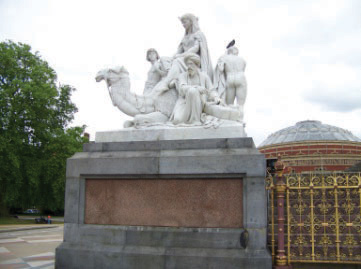
Arm representing Africa.
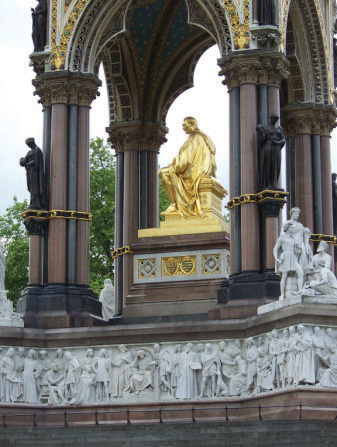
The Great Exhibition of 1851 held in the Crystal Palace, Hyde Park, London. Source: Exterior: from Dickinson's Comprehensive Pictures of the Great Exhibition of 1851, 1854 interior: William Simpson (lithographer), Ackermann & Co. (publisher), 1851, V&A.
Prince Albert’s Great Exhibition of 1851 focused attention on the technological advances made during the Industrial Revolution. Although achievements such as the building of the railroad system and the implementation of mechanized factories produced great prosperity for some, others suffered. Even before the Victorian Era, writers drew attention to these problems. Wordsworth’s “Michael,” for example, portrays a man whose family had made their living from their land for many generations. With the advent of machines to weave woolen cloth, their livelihood, their way of life, was lost. Blake’s “Chimney Sweeper” poems illustrate how children suffered in the industrial age.
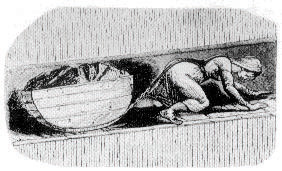
A girl pulling a coal tub in a mine. Source: Parliamentary Papers 1842.
In addition, working conditions in factories were deplorable. With no safety regulations and no laws limiting either the number of hours people could be required to work or the age of factory workers, some factory owners were willing to sacrifice the well-being of their employees for greater profit. Children as young as five worked in factories and mines. Shelley’s “Men of England” and Barrett Browning’s “The Cry of the Children” are two examples of poems written specifically to address these problems.
The 1833 Factory Act outlawed the employment of people under age eighteen at night, from 8:30 p.m. to 5:30 a.m. and limited the number of hours those under eighteen could work to twelve hours a day. For the first time, textile factory owners were forbidden to employ children under the age of nine. Children under age eleven could not work more than nine hours a day. The 1833 Factory Act also stipulated that children working in factories attend some type of school.
The Mines Act of 1842 prohibited females and boys under ten from working below ground in mines.
While these provisions hardly seem protective according to modern standards, the resulting conditions greatly improved life for many children. Throughout Victoria’s reign, other parliamentary acts continued to alleviate working conditions in the ever-expanding Victorian industrial age.
Conflicts of Faith and Doubt
The scientific and technological advances celebrated at the Great Exhibition of 1851 led to another crisis in Victorian England: a crisis of faith and doubt. During the earlier part of the 19th century, the work of Charles Lyell and other geologists with their discoveries of fossilized remains of animals never seen before led to debates among scientists about the origins of these creatures. Debates about the age of the earth for some called into question the Genesis account of creation. In 1859, Charles Darwin published his On the Origin of Species. Lyell and Darwin were among many who contributed to scientific theories that some saw as contradictory to established religious beliefs.
These scientific issues together with apparent lack of concern for appalling human conditions among the lower classes led some to doubt the presence of a divine being in the world and others to question the value of Christianity. Literature by writers such as Thomas Hardy and Matthew Arnold questions the presence of religious faith in the world.
At the same time, a conviction that Britain had a duty to spread Christianity around the world became one reason, or to some an excuse, for British imperialism.
Conflicts over Imperialism
A desire to expand industrial wealth and to have access to inexpensive raw materials led to the British occupation of countries around the globe. Although the United States and other European countries participated in this type of imperialism, the British Empire was the largest and wealthiest of its time.
Along with their desire for material gain, many British saw the expansion of the British Empire as what Rudyard Kipling referred to as “the white man’s burden,” the responsibility of the British to bring their civilization and their way of life to what many considered inferior cultures. The result of this type of reasoning was often the destruction of local cultures and the oppression of local populations. In addition, a religious zeal to bring British religion to “heathen” peoples resulted in an influx of missionaries with the colonialists.
A backlash of protest against the concept of imperialism further divided a British nation already divided by class, religion, education, and wealth. While many British citizens sincerely desired to share their knowledge and beliefs with less developed nations, others found the movement a convenient excuse to expand their country’s, and their own, power and wealth.
Conflicts over Women’s Rights
“The Queen is most anxious to enlist everyone who can speak or write to join in checking this mad, wicked folly of ‘Woman’s Rights,’ with all its attendant horrors, on which her poor feeble sex is bent, forgetting every sense of womanly feeling and propriety.”Queen Victoria, 1870
quoted in Lytton Strachey’s Queen Victoria)
Ironically, as seen in this passage from a letter written in the royal third person by Queen Victoria, even the Queen opposed women’s rights. Nonetheless, the Victorian Era did see advancement in women’s political rights. The Married Woman’s Property Act of 1870 gave married women the right to own property they earned or acquired by inheritance. The upper classes were, of course, primarily concerned with inheritances. Before the passage of this act, money or property left to a married woman immediately belonged to her husband. By the late 19th century, women had some rights to their children and the right to leave their husbands because of physical abuse.
Education for women also improved. The idea Mary Wollstonecraft expressed in her “A Vindication of the Rights of Woman” in 1792 very gradually, over more than 100 years, became a reality.
The first schools for the lower classes, girls or boys, were Sunday schools organized by churches to teach children basic literacy as well as religious lessons on the only day they were not working full time. Not until the Education Act of 1870 were public schools in all areas of the country provided by law. Even then, attendance was not made compulsory for another ten years and then only for children aged five to ten.
Girls from the lower classes were included in the first public schools; however, girls from the upper classes continued to receive their basic education primarily in the home and in finishing schools for young ladies. Cambridge University and Oxford University established the first colleges for women in the latter half of the 19th century. Women were not allowed to attend the existing colleges for men and were not considered full members of the universities until the 20th century.
Although there was an active woman’s suffrage movement during the Victorian Era, women did not receive the right to vote until the 20th century.
Take the Women’s Rights Quiz on the BBC website to see how much you know about the rights of Victorian women.
Language
The major change in the English language during the 19th century was the introduction of vocabulary to communicate new innovations, inventions, and concepts that resulted from the Industrial Age. Language mirrored class distinctions in both vocabulary and accents. The well educated upper classes were distinguished by their speech. Slang and an entirely differently accented English were the marks of the lower classes.
Forms of Literature
Novel
As noted in the Romantic Period introduction, a novel, as defined in the Holman/Harmon Handbook to Literature, is an “extended fictional prose narrative.” The novel was a dominant form in the Victorian Era. Many Victorian novelists—Charles Dickens, William Thackeray, Wilke Collins, George Eliot, Robert Louis Stevenson—wrote serial novels, novels published in installments over a period of time. Serial novels appeared in newspapers or magazines or could be published in independently printed booklets. As larger portions of the population became literate, demand for reading material grew. The inexpensive booklets, each containing a chapter or other small portion of a novel, were affordable entertainment for the middle classes.
Poetry
As in the Romantic Period, lyric poetry was popular in the Victorian Era. In addition to the lyric, the verse novel, a long narrative poem, such as Barrett Browning’s Aurora Leigh, Tennyson’s Idylls of the King, and Browning’s The Ring and the Book, also was a prevalent form. Browning popularized the dramatic monologue, a form of poetry which presents a speaker in a dramatic situation.
Non-Fiction Prose
The many conflicts of the Victorian Era provided fertile subject matter for non-fiction prose writers such as Matthew Arnold, Thomas Carlyle, John Stuart Mill, John Henry Newman, Walter Pater, and John Ruskin.
Drama
Popular forms of entertainment such as the music hall and melodramas flourished during the Victorian Era as entertainment became divided along class lines. Popular music and musical plays, separated from legitimate theater in their own venues, provided leisure-time amusement for the middle classes. Robert Browning wrote closet dramas, plays not actually intended for the stage. Oscar Wilde revived the comedy of manners with plays such as Lady Windermere’s Fan and The Importance of Being Earnest.
Key Takeaways
- Although Queen Victoria symbolized decency, decorum, and duty, Victorian society spanned a wide spectrum of prosperity and poverty, education and ignorance, progress and regression
- Victorian society wrestled with conflicts of morality, technology and industry, faith and doubt, imperialism, and rights of women and ethnic minorities.
- Many Victorian writers addressed both sides of these conflicts in many forms of literature.
- Typical forms of Victorian literature include novels, serialized novels, lyric poetry, verse novels, dramatic monologues, non-fiction prose, and drama.
Resources
Victorianism
- “All Change in the Victorian Age.” Bruce Robinson. Britain’s Industrial Revolution. Victorians. BBC History.
- “Monuments and Dust: The Culture of Victorian London.” Michael Levenson, University of Virginia; David Trotter, University College London; Anthony Wohl, Vassar College. Institute for Advance Technology in the Humanities, University of Virginia; Department of English University College London; Cambridge University Press.
- “Movements and Currents in Nineteenth-Century British Thought.” The Victorian Web. George P. Landow, Brown University.
- “Overview of the Victorian Era.” History in Focus. Anne Shepherd. University of London.
- “Victorian and Victorianism.” The Victorian Web. George P. Landow, Brown University.
- “Victorian Britain.” History Trails. BBC.
- “Victorian England: An Introduction.” Christine Roth, University of Wisconsin, Oshkosh.
- “The Victorian Period.” Dr. Robert M. Kirschen, University of Nevada, Las Vegas.
- “Victorians 1837–1901.” Liza Picard. The British Library.
- “Victorians 1850–1901.” The National Archives.
Queen Victoria
- “Queen Victoria.” The Victorian Web. David Cody, Hartwick College.
Victorian Conflicts
Conflicts of Morality
- “Addiction in the Nineteenth Century.” Dr. Susan Zieger, Stanford University.
- “The Contagious Diseases Act.” The Victorian Web.
- “The Great Social Evil”: Victorian Prostitution. Prof. Christine Roth, University of Wisconsin, Oshkosh.
- “Opium Dens and Opium Usage in Victorian England.” Victorian History. Bruce Rosen, University of Tasmania.
Conflicts of Technology and Industry
- “1832 Reform Act.” Taking Liberties: The Struggle for Britain’s Freedoms and Rights. The British Library.
- “The 1833 Factory Act [from Statutes of the Realm, 3 & 4 William IV, c. 103].” The Victorian Web. Dr. Marjie Bloy, National University of Singapore.
- “19th Century Poor Law Union and Workhouse Records.” The National Archives. brief explanation of 1834 Poor Law and images.
- “Child Labor.” The Victorian Web. David Cody, Hartwick College.
- “Corn Laws.” The Victorian Web. David Cody, Hartwick College.
- “The Crystal Palace Animation.” The Institute for Advanced Technology in the Humanities. University of Virginia.
- “The Crystal Palace, or The Great Exhibition of 1851: An Overview.” The Victorian Web.
- “Great Exhibition.” Treasures. The National Archives.
- “The Great Exhibition.” History, Periods & Styles Features. The Victoria & Albert Museum.
- “The Great Exhibition at the Crystal Palace.” Victoria Station.
- “The Life of the Industrial Worker in Nineteenth-Century England.” The Victorian Web. Laura Del Col, West Virginia University.
- “The Reform Acts.” The Victorian Web. Glenn Everett, University of Tennessee at Martin.
- “Testimony Gathered by Ashley’s Mines Commission.” The Victorian Web. Laura Del Col, West Virginia University.
Conflicts of Faith and Doubt
- “Victorian Science & Religion.” The Victorian Web. Aileen Fyfe, National University of Ireland Galway and John van Wyhe, Cambridge University.
Conflict over Imperialism
- “The British Empire.” The Victorian Web. David Cody, Hartwick College.
- “British Empire.” The National Archives.
- “Kipling’s Imperialism.” The Victorian Web. David Cody, Hartwick College.
Conflicts over Women’s Rights
- “The 1870 Education Act.” Living Heritage: Going to School. www.parliament.uk.
- “Gender Ideology & Separate Spheres.” Gender, Health, Medicine & Sexuality in Victorian England. Victoria & Albert Museum.
- “Gender Matters.” The Victorian Web.
- “The National Union of Women’s Suffrage Societies.” The Victorian Web. Helena Wojtczak.
- “‘The Personal is Political’: Gender in Private & Public Life.” Gender, Health, Medicine & Sexuality in Victorian England. Victoria & Albert Museum.
- “The Suffragettes in Parliament.” History of Parliament Podcasts. www.parliament.uk.
- “Suffragists.” Learning: Dreamers and Dissenters. The British Library.
- “Victorian Britain: A Divided Nation?” Education. The National Archives.
- “Women’s Status in Mid 19th-Century England: A Brief Overview.” Helena Wojtczak. Hastings Press.
- “Women’s Rights Quiz.” Major Events of Victoria’s Reign. Victorians. BBC History.
- “Women’s Work.” Prof. Pat Hudson, Cardiff University. Daily Life in Victorian Britain. Victorians. BBC History.
Victorian Language
- “The Development of the English Language Following the Industrial Revolution.” The Victorian Web. Jessica Courtney, University of Brighton (UK).
Literature
- “The 19th Century Novel.” Novels. Dr. Agatha Taormina, Extended Learning Institute of Northern Virginia Community College.
- “Gerard Manley Hopkins and the Difficulties of Victorian Poetry.” The Victorian Web. George P. Landow, Brown University.
- “Justifying God’s Ways to Man (and Woman): The Victorian Long Poem.” The Victorian Web. George P. Landow. Brown University.
- “Literary Genre, Mode, and Style.” The Victorian Web.
- “Nineteenth Century Drama.” Theatre Database.
- “Progress of Journalism in the Victorian Era.” Bartleby.com. The Growth of Journalism. rpt. from The Cambridge History of English and American Literature in 18 Volumes (1907–21). Vol. XIV. The Victorian Age, Part Two.
- “Serial Publication.” Prof. Joel J. Brattin, Worcester Polytechnic Institute. Dickens. Life and Career. PBS.org.
- Some Questions to Use in Analyzing Novels. Prof. Stephen C. Behrendt, University of Nebraska, Lincoln.
- “Studies of Victorian Literature.” Dr. John P. Farrell, University of Texas at Austin.
- “Victorian Literature and Culture.” Prof. James Buzard. MIT Open Courseware.
- “Victorian Serial Novels.” Digital Collections. University of Victoria Libraries.
- “Victorian Women Writers Project.” University of Indiana Digital Library Project.
- “Why Read the Serial Versions of Victorian Novels?” The Victorian Web. Philip V. Allingham, Lakehead University.
Video
- “The Albert Memorial: Symbol of the Victorian Age.” Dr. Carol Lowe, McLennan Community College.
- “The Great Exhibition.” Victorians. The British Library.
- “The Rise of Technology and Industry.” Learning: Victorians. The British Library. images, slide shows, video, podcasts featuring all types of industry and technological advances in daily life, such as cooking and bathrooms.
Audio
- “A Visitor’s Guide to the Great Exhibition, from ‘The Illustrated Exhibitor.’” The Great Exhibition. Victorians. The British Library.



